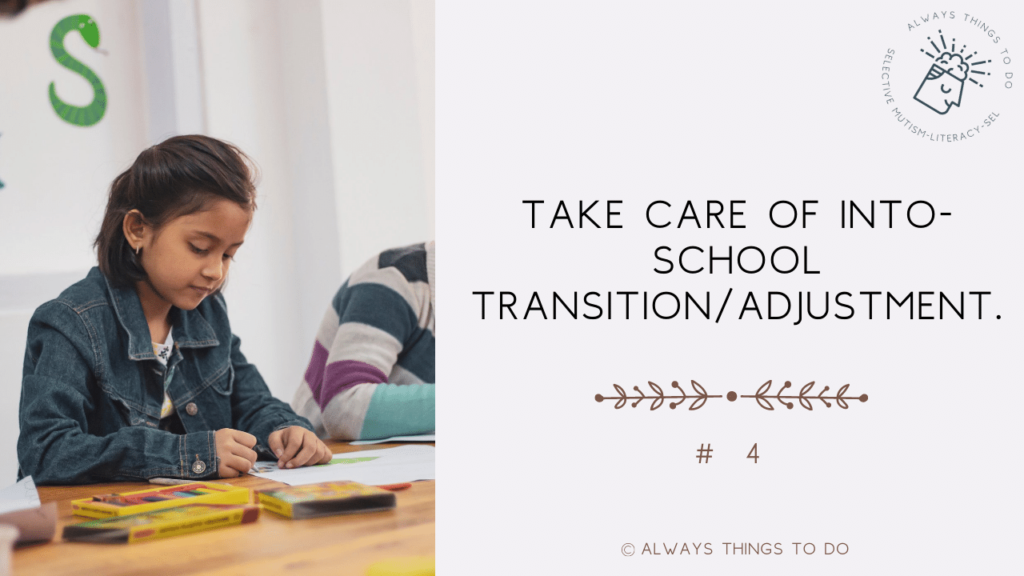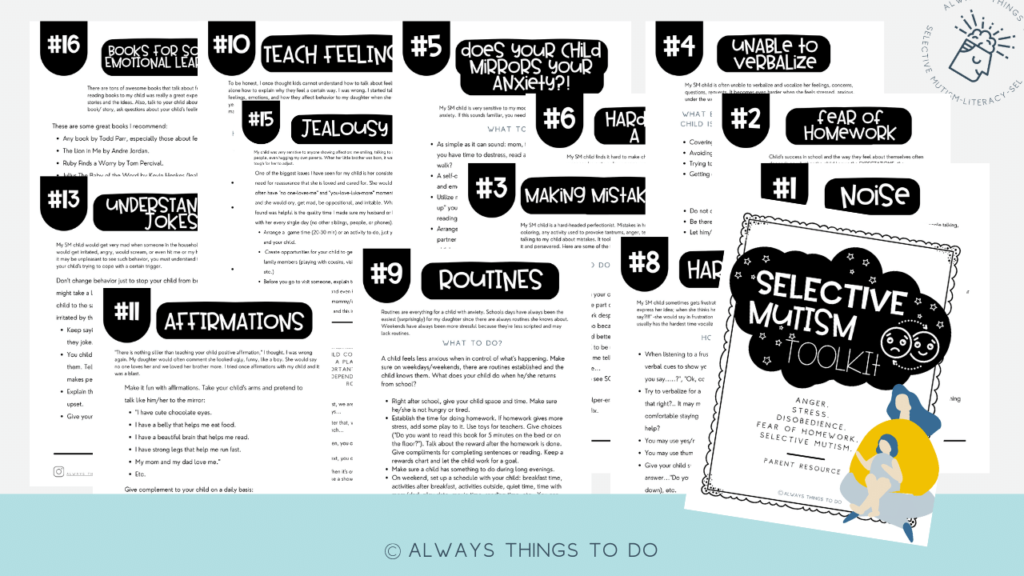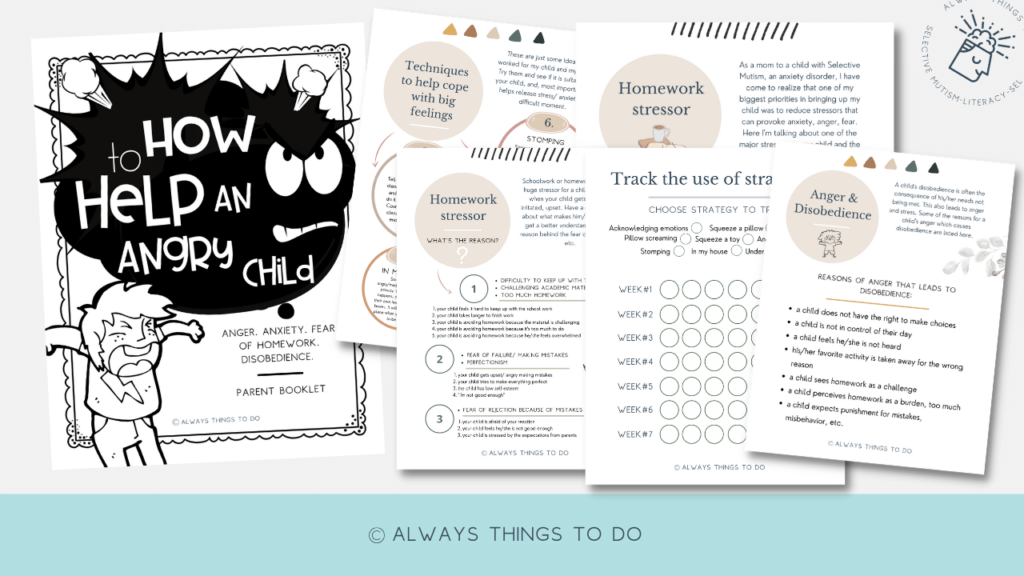7 Must-Do Things For A Parent of A Child With Selective Mutism: Actionable Tips and Resources to Consider.

Selective mutism is manageable, even though at times it seems like an overwhelming and slowly-dragging endeavor, lacking the final destination.
Most of the time it surely seems to consume all of us, my child in particular – and this is when the realization of having to deal with selective mutism, an anxiety disorder, becomes even more real. Luckily, some days feel like we are over it as if selective mutism has been gone forever as if it never happened.
Having witnessed how much progress can be done with early detection, treatment therapy, strategic school accommodations, and medication, I’m sure more optimistic now to believe my daughter’s therapist’s words, “She will not even remember that she once never spoke for two years.” As a mom of a selective mutism child, I feel happy to see that two years of hard work, running around, and learning about selective mutism have finally started to pay off.
If you ask me what exactly helped my child to overcome selective mutism, for the most part, I would say – a combination of many different things.
In this post, I’m sharing 7 things a parent can do to help a child with selective mutism if at the beginning it seems too overwhelming.
1. Do not hesitate or postpone having your child diagnosed.

Whether you are unsure or scared by the potential cost of the selective mutism treatment, you should never hesitate to take the first step – getting an official diagnosis for your child.
I know it can be hard to figure out that fine line when you still think your child is just shy or it may be actually selective mutism.
Just observing your child and their behavior or consulting the Facebook groups is a great start to get the information about what to look for in a child’s behavior that might point to selective mutism. Read “70 Selective Mutism Symptoms & 3 Diagnostic Criteria“ to find out about common selective mutism symptoms and behaviors.
The official diagnosis of selective mutism should be the first step even if you haven’t yet sorted out the question with insurance coverage or other expenses for 2 major reasons:
- you get the final decision about whether your child has an anxiety disorder or some other issues that may manifest thought symptoms similar to selective mutism.
- official diagnosis is an important step in bringing the school on the same page about the support and accommodations your child will need in the future.
Unfortunately, many health care plans do not offer coverage of selective mutism treatment. In addition, many selective mutism treatment professionals do not accept health care payment plans, which means you will have to pay from your pocket.
Having said that, I still encourage you to contact your health insurance and ask them about the possibility of partial coverage of anxiety treatment for your child. Read “Diagnosis of Selective Mutism: Simple Parent Guide and Steps to Take” to get to know about the process of diagnosis, who can diagnose, what to expect from the process, what to look out for in a selective mutism specialist who does the diagnosis or treatment.
2. Get your hands on some great tools about selective mutism.

When my daughter was diagnosed with selective mutism, I knew little about the treatment options and what to do in general.
My initial search on the Internet brought me to expensive treatment camps and programs like Brave Buddies or Mighty Mouth that range from $2000 to $4000 per event. While I do not question the value of such programs, I find them inaccessible for many families. And so was it for our family when my child was diagnosed.
Due to the high cost of treatment camps and programs, I was not able to consider them as an option, nor did I believe in the idea that something short-term can lead to long-lasting results.
While I believe working with a selective mutism treatment professional is important and recommended, there are many other free or more affordable resources available to parents.
These resources can be of great help for parents to:
- learn about selective mutism
- provide resources for a child’s school
- share resources with a psychologist or speech pathologist who has no training in working with selective mutism
Best from Books:
- Overcoming Selective Mutism: The Parent’s Field Guide by Dr. Aimee Kotrba & Shari J. Saffer
- The Selective Mutism Resource Manual: 2nd Edition (A Speechmark Practical Sourcebook) by Maggie Johnson & Alison Wintgens (Author)
- The Ideal Classroom for the Selectively Mute Child: A Guide for Parents, Teachers, and Treatment by Elisa Shipon-Blum
Best of Sites:
Teacher-Mom-made resource:
Selective Mutism Home-School Parent Toolkit
- 53 Selective mutism IEP/ 504 accommodations
- 5 Made-for-you teacher-parent daily (weekly) communication log templates (designed for selective mutism)
- Smart (verbal/ non verbal) goals/ reward chart and explanation
- 15 Most common issues of children with selective mutism and how to address them
- How to help an angry child ideas and tips (tantrums, homework issues, and more)
- 50 Interesting questions to ask a child about school without annoying them + ways for your child to respond with pictures
- 55 Suggestions of books about worry, anxiety, stress, selective mutism for your child’s teacher, and home reading

3. Choose type of therapy / SM treatment that matches your current financial capability.

Once you found your selective mutism treatment professional, it’s time to look into how much it can cost.
From a quick search, I discovered that prices of treatment per session vary depending on the level of experience and knowledge a treatment professional has. High prices are very common due to the shortage of selective mutism treatment professionals in some areas and the fact that selective mutism is pretty rare.
When I was making decisions about choosing the selective mutism treatment professional to work with my child, I was considering only one condition: the specialist’s experience with selective mutism. I personally believe, experience in treating selective mutism or even specialization in selective mutism and other disorders is a huge factor that convinces parents to opt for a specific treatment specialist.
In general, the treatment session can cost you between $150 to $300 with a treatment specialist that can bring high value a.k.a. has experience in treating selectively mute patients. Treatment sessions can be scheduled weekly or biweekly based on how “severe” selective mutism is and how intense the treatment needs to be.
If your choice is the local psychologist or speech specialist, I would expect the rates per session to be much lower, especially if a person has no experience with selective mutism in particular.
As for the format of sessions, from our family’s experience, both in-person and online (zoom) appointments worked well.
While investment in a knowledgeable and experienced selective mutism treatment professional may be a huge decision, I would like to point out that working with a specialist will also give you the following benefits:
- Support in communicating with a school about necessary accommodations,
- Participation of the selective mutism treatment professional in any IEP meetings and addressing teachers’ concerns,
- Guidance in choosing appropriate selective mutism school accommodations,
- Support in making decision about medication,
- Resource of ideas about how to support a child at home or outside when meltdowns happen,
- Accountability and support partner when you feel like giving up or feeling too overwhelmed
4. Take care of into-school transition / adjustment.

I know that taking care of into-school transition or adjustment can be quite complicated. Issues may arise when you discover that schools or educators may not be able or ready to handle selective mutism.
In general, parents’ experience of talking to school districts and teachers about selective mutism and child’s needs range from blunt denial and skepticism (unfortunately) to a genuine desire to help which eventually stumbles into How, Where, and When.
The bottom line of into-school transition is to decide whether you want your child to receive special education support as a part of IEP (individualized education plan) or some accommodation based on 504 plan.
My personal advice is you should seriously consider special education support provided by most public schools.
The process of evaluating the child to be eligible for special education services provided by the school district starts with contacting the special education department in your school district and providing the official diagnosis and a letter from a pediatrician stating the diagnosis. Once the school is on board with all the information, they will start the evaluation process.
Read “Selective Mutism IEP/504 Goals, Choice of Therapy, Activities & How to Normalize Anxiety for an Anxious Child” and “Selective Mutism Classroom Accommodations: What You Need To Know About 504 and IEP” to find out more detailed information about school accommodations.
If you are not sure whether your child needs the support provided by special education services in a school district, read “Is Selective Mutism a Disability?” to learn how selective mutism impacts the child and what to expect.
5. Invest into emotional support of your child at home.

Selective mutism is not limited to just not speaking even though a child’s inability to speak is something parents put a lot of resources into.
As a mom of a child with selective mutism, I have learned that selective mutism anxiety disorder impacts quite a lot of areas of a child’s life: social interactions, family interactions, academic progress, emotional development, self-perception, and many others.
A mute child suffers a lot. I know how hard it can be to deal with toilet issues in school and lack of socialization. I know the tantrums and creaming that usually happens after school or holidays. I know it all because I’ve been there.
What I have also learned from my child and from communicating with a selective mutism treatment professional is that the key to treating selective mutism is in addressing anxiety as the root cause of not speaking. It all starts with developing a relationship with the child and bringing anxiety to manageable levels.
When anxiety is manageable, the child is ready for school interventions that will bring them to verbalization.
However, the road to the first word can be quite long. And during this journey, a child experiences a range of strong emotions that usually surface in the comfortable environment – home.
A child with selective mutism may come home angry, irritated, pissed, sad, or upset. Inability to express themselves in a classroom setting translates into after-school meltdowns, tantrums, mood swings that can be quite hard to handle.
In addition, anxiety that impacts child’s speaking can also affect child’s academics, and you may notice it when your child with selective mutism has tantrums right before homework. The reason for it is anxiety and fear of challenges, mistakes, being wrong, being judged by mistakes, feeling not good enough, etc.
My daughter use to have such a hard time with homework. Procrastination and constant crying because of mistakes would drag homework time. She would get mad and scream if her letters look not round enough or I correct her reading or spelling.
A child’s emotional support and social-emotional learning are important layers of addressing selective mutism at home.
Here are some of the things to start doing to support your child’s emotional development:
- Read books about anxiety, being different, worry, mistakes, selective mutism, feeling lonely, emotions.
- Praise a child for accepting challenges (for example: completing homework independently) and build confidence by pointing the best in child’s work (for example, great letters, being able to read independently for 5 minutes, cleaning up the table, solving a math problem).
- Talk about feelings and teach your child language to express emotions (I’m upset because… I worry because… I feel lonely because…).
- Teach your child emotions management and how emotions impact behavior.
- Make sure you, as a parent, have enough emotional resource to be able to face your child’s big emotional needs and tantrums. To do that, you need the time to recharge.
Consider these two resources from the “Selective Mutism Home-School Parent Toolkit”:
- How to help an angry child: tantrums, anger, disobedience, fear of homework.
- Selective Mutism Toolkit: 15 most common struggles of children with selective mutism

If all the things seem like too much, read “6 Things You Can Do Right Now To Help Your Child With Selective Mutism.”
6. Rethink how you feel about selective mutism and adopt a long-term vision.

For almost 2 years of my child’s treatment for selective mutism I’ve felt like the life of the whole family was put on pause.
First of all, selective mutism can be draining emotionally.
Second, as I said before, selective mutism is not just about not speaking. This anxiety disorder impacts so many areas of life.
Trying to get rid of selective mutism was the wrong goal. I felt mentally exhausted for almost two years before I realized that my perception of the selective mutism of my child needed to change.
I stopped demonizing selective mutism. I stopped apologizing for my child’s not speaking or being upset during a birthday party. I started looking at things as something manageable and something that will give results if we are persistent and consistent enough.
Understanding that certain things just need time is essential.
Do not try to make your child speak in a few months even if the school has all the accommodations are in place.
It will take time.
Do not expect your child starts using the bathroom at school if he/she is still scared of that and is not verbal.
It will take time and learning.
Do not expect your child to join the after-school club and agree to be there while being in public is still a huge anxiety trigger for your child.
It will take time.
Do not expect teachers to understand how to work with your child right away.
It will take time and learning.
In fact, I believe trying to find fast solutions to the problems related to selective mutism is wrong and ineffective. While I urge all the parents to be active advocates for your child’s treatment and support in school, I also advise all the parents to give it time and drop expectations that are connected to fast results.
Read “Selective Mutism: How to Beat Crisis, Screaming, Fear” to get my takeaways of what 2 years of dealing with selective mutism look like.
7. Learn to support your child in academics.

My daughter’s and my hardest year was in her Kindergarten. She was absolutely mute.
I would receive dozens of messages from my child’s teacher about her requiring 1-on-1 assistance, the teacher being at a loss about how to assess her skills and knowledge, my child’s not doing well in writing.
Because I’m a teacher myself I knew how to address it. To help my daughter in academics and ensure she is progressing despite being mute at school, I invested a lot of time in supporting her at home.
Because she was a reluctant reader and writer, I flooded our house with books and would read to my child every day. We did reading challenges and played writing games.
At times it would drag, and sometimes it would go well. I just persisted and continued doing something every day.
A child with selective mutism may struggle in academics due to anxiety and not being able to fully participate in the learning process because of mutism. You can support your child by:
- Having a conversation with teachers about the areas that require improvement and identifying the causes of your child’s struggles,
- Negotiating with teachers alternative ways of assessing a child,
- Supporting your child in doing homework, praising efforts, taking about “mistakes are OK”, etc.
- Considering special education support though an IEP plan or 504 plan,
- Addressing self-esteem issues by highlighting the smallest wins and breaking bigger tasks into manageable chunks,
- Incorporating timer into many homework activates.
Read “Routines For School: How To Help a Reluctant & Anxious Child Thrive in Daily Routines and Reading” to get more ideas about how to support your child at school and address the issues of a reluctant reader.
If you liked the information in this post, make sure you explore other posts about selective mutism:
- “What Is Selective Mutism?”
- “Selective Mutism: How To Beat Crisis, Screaming, and Fear.”
- Diagnosis of Selective Mutism: Simple Parent Guide and Steps to Take.
- What Are The Causes of Selective Mutism?
- Is Selective Mutism a Disability?
- How Do You Treat Selective Mutism?
- 70 Selective Mutsim Symptoms & 3 Diagnostic Criteria.
- Selective Mutism Myths: Most Common Concerns Addressed.
- Selective Mutism Classroom Accommodations: What You Need To Know About 504 and IEP.
- 6 Things You Can Do Right Now To Help Your Child With Selective Mutism.
Check out the expanding library of tools. Go to the selective mutism page and scroll to the bottom section, “Latest Projects.”
Connect with me on social media @alwaysthingstodo.




